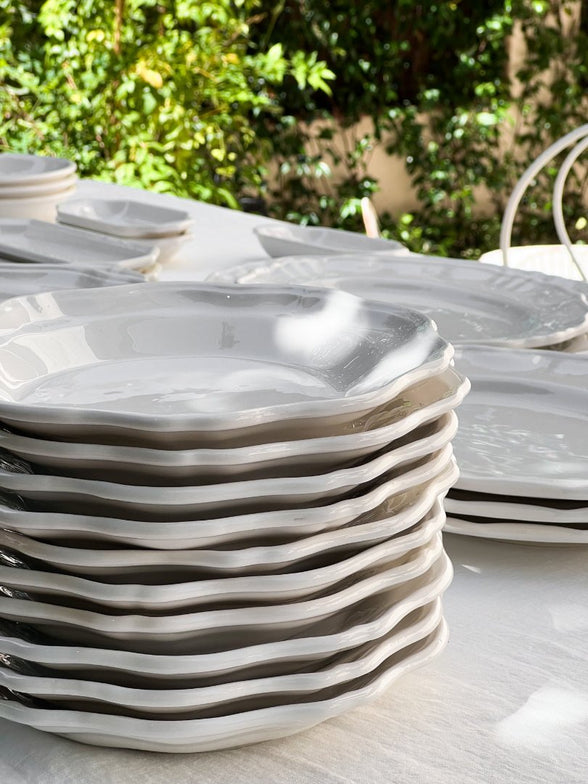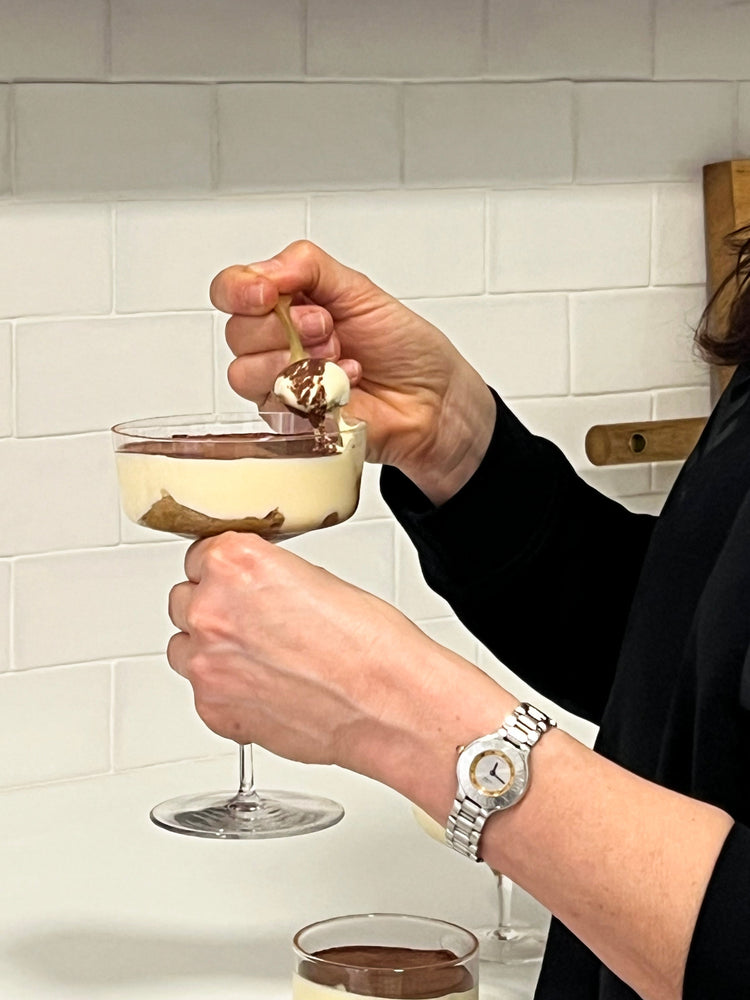Rosario Tableware
AN ARTISAN PROCESS OF 19 DAYS AND 10 STEPS
A collection inspired by our mother, named in her honour.
Our Rosario tableware collection, made for Villa Las Perelli, is produced in small quantities in Spain through a traditional and artisanal process that combines the use of the hydraulic press with the manual work of the craftsman. It is composed of different pieces that share a design inspired by the past.
The pieces of the Rosario dinnerware are made for Villa Las Perelli in a family workshop in Spain using white earthenware produced in Manises (Valencia) and formulated in England.

White earthenware pieces and the Villa Las Perelli hallmark that the artisan puts on each piece one by one
PREPARATION OF THE EARTHENWARE
To prepare the earthenware, the air is extracted from the earthenware cakes by introducing them into a kneading machine, thus obtaining blocks of earthenware of different sizes that will be used according to the size of the piece that we want to produce.
FIRST MOULDING
The next step is the moulding of the piece with the hydraulic press.
The craftsman uses the same hydraulic press to make the different pieces, changing the mould for each one. The mould is made up of two parts: the female part is placed at the bottom and the male part at the top. The process of changing the moulds in the press can take up to a day between replacement and cleaning. The artisan carries out this process every time he changes the piece or the type of earthenware.
To obtain the first moulding of the piece, he inserts the piece of earthenware into the female part of the mould. This rises upwards, flattening the piece against the upper part, generating a surplus of earthenware that comes out of the sides (burr) and is removed when the lower piece is lowered. The burr accumulates in a container to be reused (it will be reintroduced in the process described in the first step). The piece of earthenware sticks to the top of the press. At this point, the artisan puts our stamp on the bottom of the piece by hand. He removes it by pressing the pedal that activates the air passage of the compressor, which removes it and lets it fall onto a wooden board that he holds in his hand. This process is repeated numerous times as many times as pieces are produced in the run.
 Craftsman removing the excess of the pressed piece (burr) and putting the stamp on it before removing it from the press
Craftsman removing the excess of the pressed piece (burr) and putting the stamp on it before removing it from the press
DRYING
Once the pieces have been moulded, they are left to dry so that they become more rigid and can be worked with. They are left for two days in a damp drying room. It is important that the pieces do not dry outside the drying room and that they are not near the heat to prevent the piece from cracking.

First shape of the Rosario trays size L, ready to be taken to the drying room

Artisan introducing the trays into the wet dryer for the first drying process
FINISHING AND SMOOTHING
Once the pieces have hardened, the potter smoothes them one by one by hand. He places the piece on a turning wheel that rotates on itself and with a blade he removes the excess earthenware from the edge of the piece. He then smoothes the piece with a damp sponge to make it smooth and finished.

Refinishing area where the potter touches up each piece one by one with a knife, sandpaper and sponge
SECOND DRYING
Once the pieces have been retouched, they are left to dry again, this time in a less humid drying area. The piece remains there for about a week until it is completely dry. This time varies according to the season of the year, taking longer in winter and less in summer.
FIRST BAKING
Once dry, the pieces are placed in the kiln cars. The gas oven is approximately 2 cubic metres in size and reaches a temperature of 1040 degrees. The pieces are baked for 14 hours and then cool for two and a half days. This is how we obtain the baked earthenware pieces ready for glazing.

Pieces after the first baking from tray size L of our Rosario collection.
GLAZING
Before glazing, the pieces are checked one by one for any imperfections. If any piece needs to be touched up, the potter sands the area very smoothly with fine sandpaper and a well-drained sponge.
Once ready to glaze, the potter prepares the glaze mixture with water by stirring with a paddle or whisk to make it liquid. He immerses the piece in glaze holding it with a pair of glazing tongs and holds it for a second or several seconds, depending on the piece. He takes it out and lets it drain a little, and places it on a shelf to let it dry.
The piece takes a few hours to dry. Once dry, the excess glaze is removed from the bottom. This phase is very important because if the part of the piece that is going to rest in the kiln has some glaze on it, the piece will stick to the kiln plate.
SECOND BAKING
Once the glaze has been removed from the bottom, the pieces are put back into the oven, taking great care to ensure that the pieces do not touch each other, otherwise they will stick together. The pieces are fired at 950 degrees for 7 hours. The cooling time is approximately 12 hours.
Each piece of our Rosario dinnerware takes a minimum of 19 days to make and goes through 10 different steps: preparation of the earthenware, placing the moulds in the press, making the pieces in the press, first drying, retouching and smoothing, second drying, first kiln, retouching and glazing, second kiln and last drying.
First molding of the trays with the hydraulic press.













